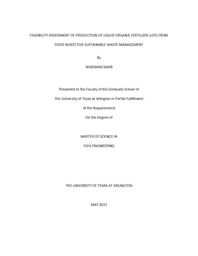
ATTENTION: The works hosted here are being migrated to a new repository that will consolidate resources, improve discoverability, and better show UTA's research impact on the global community. We will update authors as the migration progresses. Please see MavMatrix for more information.
Show simple item record
| dc.contributor.advisor | HOSSAIN, MD SAHADAT | |
| dc.creator | Sakib, Shadman | |
| dc.date.accessioned | 2022-07-19T12:19:59Z | |
| dc.date.available | 2022-07-19T12:19:59Z | |
| dc.date.created | 2021-05 | |
| dc.date.issued | 2021-05-04 | |
| dc.date.submitted | May 2021 | |
| dc.identifier.uri | http://hdl.handle.net/10106/30761 | |
| dc.description.abstract | The increasing volume of food waste is responsible for the generation of potent greenhouse gases and is resulting in the wastage of valuable resources. In all regions of the world, the percentage of food waste in municipal solid waste is greater. Due to the lack of waste segregation at collection points and modern waste disposal methods in developing countries, organic waste is piling up in the dumpsites and landfills. Besides due to poor harvest and post-harvest procedures and inefficient supply chain, almost 55% of the cultivated crops do not even reach the consumers and get wasted. On the other hand, to feed the growing population, huge volumes of chemical fertilizers are being used, which is detrimental to the environment. The use of liquid organic fertilizer (LOF) produced from the waste can be a sustainable solution for these problems. This experimental work focused on the reduction of fruit and vegetable waste, by using the leachate generated from it as an alternative to chemical fertilizer. Wastes generated by the consumption of fruit and vegetables were stored in closed buckets and pH, nitrogen, phosphate, and potash content of the leachate produced were monitored for 28 days at 7 days intervals. For this experimental work, 10 fruits and 18 vegetables samples were used. Since, nitrogen, phosphate, and potash are major nutrients required for plant growth, the study was concentrated on these three. Data analysis showed that the leachate from the fruit and vegetable waste is respectively acidic and basic in nature and a mixture of these two produces neutral leachate. The leachates generated from both fruits and vegetables lack nitrogen content, whereas these are rich in potash content. The phosphate content was found to be almost 20 % of the potash content. Similar trends were also seen for mixtures of fruit and vegetable waste. Thus, the leachate from the fruit and vegetable waste has the potential to fulfill the potash requirement of the soil and crops requiring a greater quantity of potash for higher yield. A simple equation and corresponding charts were proposed at the end of this study, which can be used to determine the mass of solid waste (fruit, vegetable, and mixed waste) required to produce the leachate that can fulfill the nutrient deficiency for a particular crop. | |
| dc.format.mimetype | application/pdf | |
| dc.language.iso | en_US | |
| dc.subject | Sustainable waste management | |
| dc.subject | Liquid organic fertilizer | |
| dc.title | FEASIBILITY ASSESSMENT OF PRODUCTION OF LIQUID ORGANIC FERTILIZER (LOF) FROM FOOD WASTE FOR SUSTAINABLE WASTE MANAGEMENT | |
| dc.type | Thesis | |
| dc.degree.department | Civil Engineering | |
| dc.degree.name | Master of Science in Civil Engineering | |
| dc.date.updated | 2022-07-19T12:19:59Z | |
| thesis.degree.department | Civil Engineering | |
| thesis.degree.grantor | The University of Texas at Arlington | |
| thesis.degree.level | Masters | |
| thesis.degree.name | Master of Science in Civil Engineering | |
| dc.type.material | text | |
| dc.creator.orcid | 0000-0001-5733-8203 | |
Files in this item
- Name:
- SAKIB-THESIS-2021.pdf
- Size:
- 16.61Mb
- Format:
- PDF
This item appears in the following Collection(s)
Show simple item record


